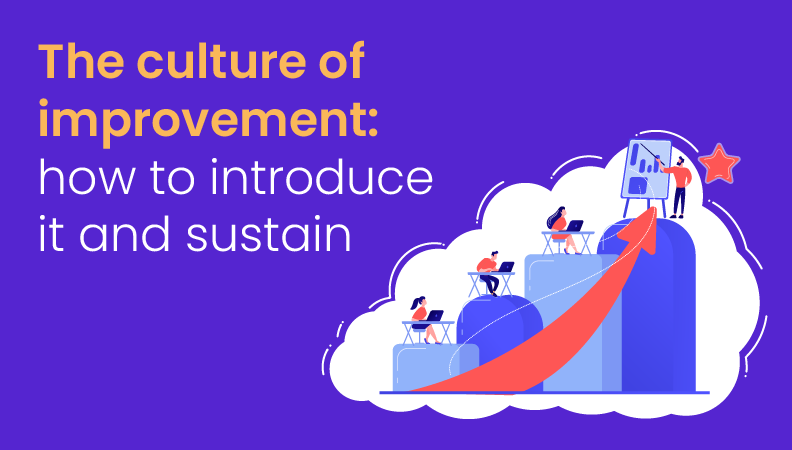
The culture of improvement: how to introduce it and sustain
Working cultures and approaches vary in each company. This culture of improvement is what drives a company forward. Introducing it might be difficult and sustaining is even more difficult. It takes time and effort to invest in bringing this culture to a team.
You need to start somewhere. But on which base can you establish this culture and make it grow?
The answer is– EXPERIMENT!
Experiments as the Basis of All Progress
As I said and we all know, all companies have different work cultures. So, naturally, it’s impossible for every company to adopt the same strategy and get positive results.
In the past years, everything from PR to marketing, ads, management strategies have changed. Earlier “tried and tested” methods are not applicable anymore. Hence, it’s good to introduce a culture of experimentation in the company. Some companies experiment with advertisements by tapping into social and political issues.
Culture of Experiment involves the implementation of new ideas or solutions without restricting this to certain departments.
Taking risks is an essential part of it all. Even if you fail, you’ll have a better understanding of what not to do. Hence, a continuous improvement mentality is also essential.
Continuous Improvement as a Way of Thinking
Continuous improvement shares the belief that whatever is “tried and tested” today will no longer be relevant tomorrow. It instills in people the desire to become better every single day. Even though the continuous improvement approach is hard to implement, the benefits are worth the effort. These include:
1. Innovative strategies
Companies that incorporate continuous improvement approaches tend to be more innovative than the ones that do not. Toyota is a good example of this.
2. Employee turnover and engagement
Employees are the “limbs” of a company. They learn new skills and become more competitive by incorporating continuous improvement. This is followed by a huge turnover in business.
3. Competition
Updated strategies and successful experiments have great potential for companies to reach new heights and win the competition. At the same time, at the level of staff, experiments in team culture, working culture and internal management too, employees get the opportunity to polish their skills and get new ones.
By now, you might be like “That’s great. But how do I incorporate the culture of improvement and sustain it?”. Don’t worry, I’ve got you covered.
Introducing the Culture of Improvement Into the Working Environment
Introducing an improvement culture is easier said than done. It’s hard to change how and what people think, but it’s possible to influence behavioral changes without restricting them. Here are some practical ways to help you get started:
- Create a calm atmosphere: always leave your door open for conversations and feedback
- Choose the processes that fit your company (Continuous improvement, Lean, etc.)
- Actions speak louder. Place your employees high and your customers even higher. A leader should guide employees.
- Set up hassle-free onboarding and hiring processes
Key Principles of an Improvement Culture to Follow
These practices are a must if you want your company to adopt and successfully implement them.
1. Place customers atop the pedestal
Any change in the product should be done considering these questions
Is it useful for the customer?
Will the customer have a much better experience than before?
What does my customer actually need?
Understanding their needs is essential. Avoid unnecessary changes and stick to consistent improvement.
2. Hear your employees
An improvement culture requires the coordination of both the leader and the employees. A leader should hear the employee’s ideas and not bash them if the idea is terrible. It empowers people to innovate and incorporates problem-solving skills in them.
3. Set goals and collect customer feedback
Setting goals is a great way of analyzing your progress. Long–term goals must be the new normal.
Collecting customer feedback is critical for the enhancement of business strategies. It’s a powerful strategy, more often than not, overlooked by many companies.
Failure and Success: The Improvement Zigzag
Even though the plus–points seem fantastic, it takes a lot of consistent work to implement culture improvement in workplaces. With that, there is a huge chance of failure. Here are some reasons why most companies fail to implement them:
- Unrealistic or unclear goals
- Unavailability of active leadership
- Not practicing it daily
- Unhealthy workplace
However, the success derived from it is worth it. This includes:
- Happy clients and employees
- Increased turnover and revenue
- Improved customer trust
- Increased brand value
But in order to reap the benefits, the culture should sustain. The next point lets you know how you can sustain it.
Sustaining the Achievement: Improvement as a Working Culture
The leaders and the employees might try to incorporate improvement as a working culture. But, can it sustain? Sustainability is the hard part of the game. You could be motivated to do it for a week and the next day, you’re back to the old working conditions.
1. Be willing to fail
It’s completely alright to fail at a new thing. At least, you learned something and you won’t make the same mistake again.
2. Listen and treat your employees with respect
Respect is a valuable thing. Treat your employees with respect and the company will move forward as a whole.
3. Seek Improvements and be supportive
A leader’s role is to support and empower their team. If a team member does not have the right knowledge and training to do his job; it’s the leader’s job to provide the resources for them.
Conclusion
Implementation and sustainability of improvement culture are necessary if a company wants to reach great heights. Experiments help launch an attractive process in which you keep testing, changing, optimizing things. It may actually become very addictive. And it’s the real indicator that you and your team have finally adopted the culture of improvement. It now is a matter of sustaining it.
Is your company implementing such methods?
What enhancements have you seen until now?

